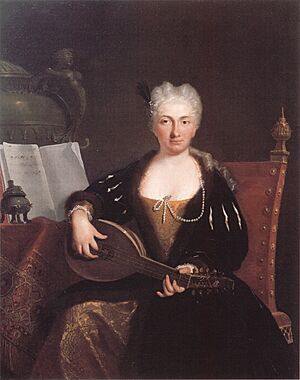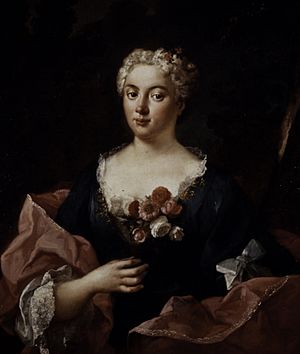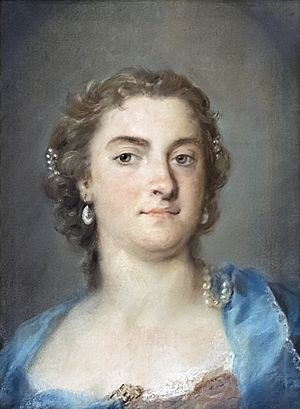Faustina Bordoni facts for kids
Faustina Bordoni (born March 30, 1697 – died November 4, 1781) was a famous Italian opera singer. She had a beautiful voice called a mezzo-soprano, which is a type of female singing voice.
Today, in Hamburg, Germany, there's a museum dedicated to her husband, Johann Adolph Hasse, and it also tells part of Faustina's story.
Contents
Early Life and Career
Faustina Bordoni was born in Venice, Italy. She grew up with the help of two noble brothers who were also composers: Alessandro Marcello and Benedetto Marcello. Her singing teacher was the composer Michelangelo Gasparini.
Faustina started her opera career in Venice in 1716. She sang in many operas there until 1725. During this time, she performed in works by famous composers like Tomaso Albinoni and Leonardo Vinci. In 1718 and 1719, she even sang alongside Francesca Cuzzoni, who later became her well-known rival.
Faustina also performed in other Italian cities like Naples and Parma. In 1723, she sang in Munich, Germany, and became very popular in Europe. People called her the "new siren," and she was often simply known as "Faustina."
The Rival Queens
Faustina made her first appearance in London on May 5, 1726. She sang in Handel's opera Alessandro. She performed with other famous singers like Senesino and Francesca Cuzzoni.
Over the next two years, she created four more roles in Handel's operas, including Admeto and Riccardo Primo.
A famous event happened on June 6, 1727, during a performance of an opera called Astianatte. A fight broke out in the audience between the fans of Faustina and the fans of her 'rival' Cuzzoni. This happened at the King's Theatre in London, with the Princess of Wales watching!
New information shows that it was mostly the fans who were causing trouble, not the singers themselves. Faustina and Cuzzoni had worked together before in Italy and continued to perform together. The opera company eventually closed in 1728 because of money problems.
Later Career and Retirement
Unlike Cuzzoni, Faustina never returned to England. From 1728 to 1732, she performed a lot in major Italian cities, especially Venice.
In 1730, she married the German composer Johann Adolf Hasse. The next year, they were invited to the court of Augustus II the Strong in Dresden. Faustina had a huge success there in her husband's opera Cleofide. A famous writer named Pietro Metastasio called them "truly an exquisite couple."
Hasse stayed at the court in Dresden for over 30 years. Faustina sang in at least 15 of his operas. However, she was allowed to travel often to Italy. She performed in Naples, Venice, and Parma in operas by composers like Giovanni Battista Pergolesi and Nicola Porpora.
Faustina stopped performing in the theater in 1751. But she kept her salary and her title as a special singer for the Elector until he died in 1763.
After this, she and her husband moved to Vienna, and then finally to Venice in 1773. Wolfgang Amadeus Mozart visited her in 1769. Faustina and Hasse had two daughters, who also became singers.
In 1772, a writer named Charles Burney visited Faustina. He described her as a "lively old woman" who still had some of the beauty she was known for when she was young. Unlike her rival Cuzzoni, who died poor, Faustina had a happy and comfortable old age.
Her Artistic Talent
Charles Burney noted that Faustina had a very strong "E" note in her voice. It's interesting that many of the songs Handel wrote for her were in keys that would make this note stand out. This shows how composers wrote music to highlight a singer's special talents.
See also
 In Spanish: Faustina Bordoni para niños
In Spanish: Faustina Bordoni para niños




